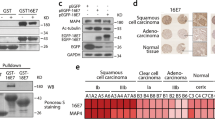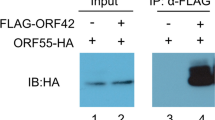Abstract
The aim of the study was to explore the interactions of human papilloma virus 16 (HPV16) E2 protein and Daxx. The localization or co-localization of PML and E2 with Daxx in Caski cells was observed by indirect immunofluorescence. The interaction of E2 and Daxx was analyzed by co-immunoprecipitation, Western-blot and yeast-two hybrid assays. In Caski cells the fluorescence of Daxx and PML was mainly distributed in the cytoplasm or nucleus, respectively, and in the align image their signals did not overlap. However, when the red signal of HPV16 E2 and the green signal of Daxx in the cytoplasm of Caski cells were merged, the yellow signal appeared. The yeast co-transformed with pGBKT7/Daxx and pGADT7/E2 or pGADT7/E2 TAD can grow on SD/-Trp-Leu-His and SD/-Trp-Leu-His-Ade plates. So Daxx is not colocated with PML but with HPV16 E2 mainly in the cytoplasm of Caski cells. On the base of the results one can propose that HPV16 E2, in particularly its transcription-activity domain (TAD), interacts with Daxx.
Similar content being viewed by others
References
Howley P.M., Lowy D.R. 2007. Papillomaviruses. In: Fields Virology, 5th ed. Eds. Knipe D.M., Howley P.M. Philadelphia, PA: Lippincott, Williams & Wilkins, pp. 2299–2354.
zur Hausen H. 2009. Papillomaviruses in the causation of human cancers: A brief historical account. Virology. 384, 260–265. doi 10.1016/j.virol.2008.11.046
Schenker A., Straub E., Iftner T., Stubenrauch F. 2013. Cell-type-dependent activities of regulatory regions and E2 proteins derived from carcinogenic and non-carcinogenic human alphapapillomaviruses. J. Gen. Virol. 94, 1343–1350. doi 10.1099/vir.0.049072-0
Dong G., Broker T.R., Chow L.T. 1994. Human papillomavirus type 11 E2 proteins repress the homologous E6 promoter by interfering with the binding of host transcription factors to adjacent elements. J. Virol. 68, 1115–1127.
Baxter M.K., McBride A.A. 2005. An acidic amphipathic helix in the bovine papillomavirus E2 protein is critical for DNA replication and interaction with the E1 protein. Virology. 332, 78–88.
Yang X., Khosravi-Far R., Chang H.Y., Baltimore D. 1997. Daxx, a novel Fas-binding protein that activates JNK and apoptosis. Cell. 89, 1067–1076.
Chen S.F., Zhu C.M., Wan Y.P. 2009. Progress on the subcellular localization of Daxx. Ai Zheng. 28, 1333–1336.
Lindsay C.R., Morozov V.M., Ishov A.M. 2008. PML NBs (ND10) and Daxx: From nuclear structure to protein function. Front Biosci. 13, 7132–7142.
Hwang J., Kalejta R.F. 2007. Proteasome-dependent, ubiquitin-independent degradation of Daxx by the viral pp71 protein in human cytomegalovirus-infected cells. Virology. 367, 334–338.
Zydek M., Uecker R., Tavalai N., Stamminger T., Hagemeier C., Wiebusch L. 2011. General blockade of human cytomegalovirus immediate-early mRNA expression in the S/G2 phase by a nuclear, Daxx- and PML-independent mechanism. J. Gen. Virol. 92, 2757–2769. doi 10.1099/vir.0.034173-0
Zhao L.Y., Colosimo A.L., Liu Y., Wan Y., Liao D. 2003. Adenovirus E1B 55-kilodalton oncoprotein binds to Daxx and eliminates enhancement of p53-dependent transcription by Daxx. J. Virol. 77, 11809–11821.
Schreiner S., Wimmer H., Sirma H., Everett R.D., Blanchette P., Groitl P., Dobner T. 2010. Proteasome-dependent degradation of Daxx by the viral E1B-55K protein in human adenovirus-infected cells. J. Virol. 84, 7029–7038. doi 10.1128/JVI.00074-10
Stevenson M., Hudson L.C., Burns J.E., Stewart R.L., Wells M., Maitland N.J. 2000. Inverse relationship between the expression of the human papillomavirus type 16 transcription factor E2 and virus DNA copy number during the progression of cervical intraneoplasia. J. Gen. Virol. 81, 1825–1832.
Maitland N.J., Conway S., Wilkinson N.S., Ramsdale J., Morris J.R., Sanders C.M., Burns J.E., Stern P.L., Wells M. 1998. Expression patterns of the human papillomavirus type 16 transcription factor E2 in low- and high-grade cervical intraepithelial neoplasia. J. Pathol. 186. 275-280.
Lin Z., Yemelyanova A.V., Gambhira R., Jagu S., Meyers C., Kirnbauer R., Ronnett B.M., Gravitt P.E., Roden R.B. 2009. Expression pattern and subcellular localization of human papillomavirus minor capsid protein L2. Am. J. Pathol. 174, 136–143. doi 10.2353/ajpath.2009.080588
Author information
Authors and Affiliations
Corresponding author
Additional information
Published in Russian in Molekulyarnaya Biologiya, 2014, Vol. 48, No. 4, pp. 682–686.
The article is published in the original.
Shuang-Yang Tang and Le Li were equal contributors.
Rights and permissions
About this article
Cite this article
Tang, S.Y., Li, L., Liu, Y. et al. Interaction of Daxx and human papillomavirus type 16 E2 protein. Mol Biol 48, 594–598 (2014). https://doi.org/10.1134/S0026893314040165
Received:
Accepted:
Published:
Issue Date:
DOI: https://doi.org/10.1134/S0026893314040165




